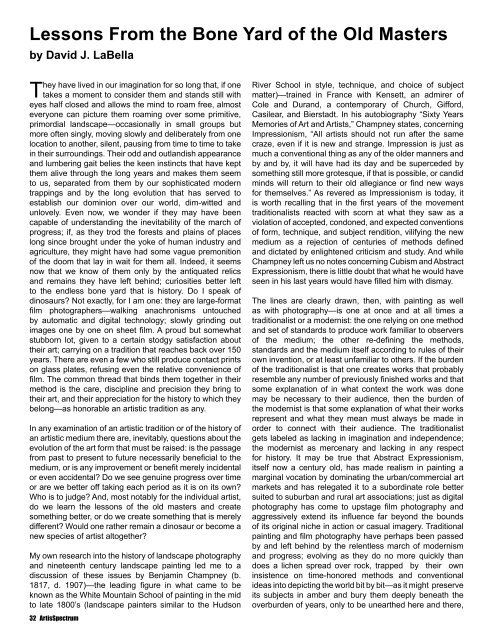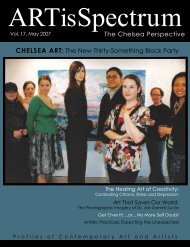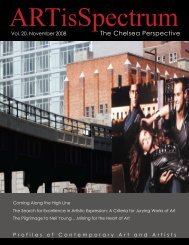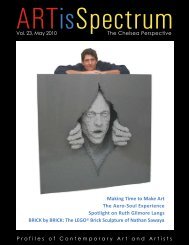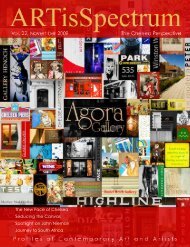Download PDF - ARTisSpectrum
Download PDF - ARTisSpectrum
Download PDF - ARTisSpectrum
Create successful ePaper yourself
Turn your PDF publications into a flip-book with our unique Google optimized e-Paper software.
Lessons From the Bone Yard of the Old Masters<br />
by David J. LaBella<br />
They have lived in our imagination for so long that, if one<br />
takes a moment to consider them and stands still with<br />
eyes half closed and allows the mind to roam free, almost<br />
everyone can picture them roaming over some primitive,<br />
primordial landscape—occasionally in small groups but<br />
more often singly, moving slowly and deliberately from one<br />
location to another, silent, pausing from time to time to take<br />
in their surroundings. Their odd and outlandish appearance<br />
and lumbering gait belies the keen instincts that have kept<br />
them alive through the long years and makes them seem<br />
to us, separated from them by our sophisticated modern<br />
trappings and by the long evolution that has served to<br />
establish our dominion over our world, dim-witted and<br />
unlovely. Even now, we wonder if they may have been<br />
capable of understanding the inevitability of the march of<br />
progress; if, as they trod the forests and plains of places<br />
long since brought under the yoke of human industry and<br />
agriculture, they might have had some vague premonition<br />
of the doom that lay in wait for them all. Indeed, it seems<br />
now that we know of them only by the antiquated relics<br />
and remains they have left behind; curiosities better left<br />
to the endless bone yard that is history. Do I speak of<br />
dinosaurs? Not exactly, for I am one: they are large-format<br />
film photographers—walking anachronisms untouched<br />
by automatic and digital technology; slowly grinding out<br />
images one by one on sheet film. A proud but somewhat<br />
stubborn lot, given to a certain stodgy satisfaction about<br />
their art; carrying on a tradition that reaches back over 150<br />
years. There are even a few who still produce contact prints<br />
on glass plates, refusing even the relative convenience of<br />
film. The common thread that binds them together in their<br />
method is the care, discipline and precision they bring to<br />
their art, and their appreciation for the history to which they<br />
belong—as honorable an artistic tradition as any.<br />
In any examination of an artistic tradition or of the history of<br />
an artistic medium there are, inevitably, questions about the<br />
evolution of the art form that must be raised: is the passage<br />
from past to present to future necessarily beneficial to the<br />
medium, or is any improvement or benefit merely incidental<br />
or even accidental? Do we see genuine progress over time<br />
or are we better off taking each period as it is on its own?<br />
Who is to judge? And, most notably for the individual artist,<br />
do we learn the lessons of the old masters and create<br />
something better, or do we create something that is merely<br />
different? Would one rather remain a dinosaur or become a<br />
new species of artist altogether?<br />
My own research into the history of landscape photography<br />
and nineteenth century landscape painting led me to a<br />
discussion of these issues by Benjamin Champney (b.<br />
1817, d. 1907)—the leading figure in what came to be<br />
known as the White Mountain School of painting in the mid<br />
to late 1800’s (landscape painters similar to the Hudson<br />
32 ArtisSpectrum<br />
River School in style, technique, and choice of subject<br />
matter)—trained in France with Kensett, an admirer of<br />
Cole and Durand, a contemporary of Church, Gifford,<br />
Casilear, and Bierstadt. In his autobiography “Sixty Years<br />
Memories of Art and Artists,” Champney states, concerning<br />
Impressionism, “All artists should not run after the same<br />
craze, even if it is new and strange. Impression is just as<br />
much a conventional thing as any of the older manners and<br />
by and by, it will have had its day and be superceded by<br />
something still more grotesque, if that is possible, or candid<br />
minds will return to their old allegiance or find new ways<br />
for themselves.” As revered as Impressionism is today, it<br />
is worth recalling that in the first years of the movement<br />
traditionalists reacted with scorn at what they saw as a<br />
violation of accepted, condoned, and expected conventions<br />
of form, technique, and subject rendition, vilifying the new<br />
medium as a rejection of centuries of methods defined<br />
and dictated by enlightened criticism and study. And while<br />
Champney left us no notes concerning Cubism and Abstract<br />
Expressionism, there is little doubt that what he would have<br />
seen in his last years would have filled him with dismay.<br />
The lines are clearly drawn, then, with painting as well<br />
as with photography—is one at once and at all times a<br />
traditionalist or a modernist: the one relying on one method<br />
and set of standards to produce work familiar to observers<br />
of the medium; the other re-defining the methods,<br />
standards and the medium itself according to rules of their<br />
own invention, or at least unfamiliar to others. If the burden<br />
of the traditionalist is that one creates works that probably<br />
resemble any number of previously finished works and that<br />
some explanation of in what context the work was done<br />
may be necessary to their audience, then the burden of<br />
the modernist is that some explanation of what their works<br />
represent and what they mean must always be made in<br />
order to connect with their audience. The traditionalist<br />
gets labeled as lacking in imagination and independence;<br />
the modernist as mercenary and lacking in any respect<br />
for history. It may be true that Abstract Expressionism,<br />
itself now a century old, has made realism in painting a<br />
marginal vocation by dominating the urban/commercial art<br />
markets and has relegated it to a subordinate role better<br />
suited to suburban and rural art associations; just as digital<br />
photography has come to upstage film photography and<br />
aggressively extend its influence far beyond the bounds<br />
of its original niche in action or casual imagery. Traditional<br />
painting and film photography have perhaps been passed<br />
by and left behind by the relentless march of modernism<br />
and progress; evolving as they do no more quickly than<br />
does a lichen spread over rock, trapped by their own<br />
insistence on time-honored methods and conventional<br />
ideas into depicting the world bit by bit—as it might preserve<br />
its subjects in amber and bury them deeply beneath the<br />
overburden of years, only to be unearthed here and there,


